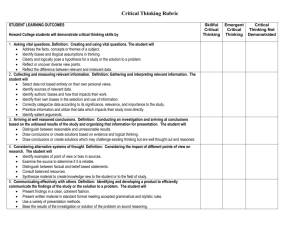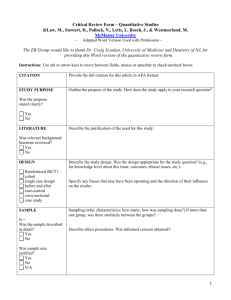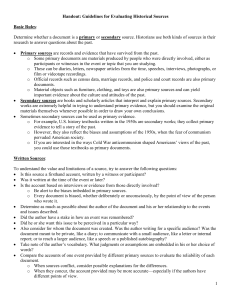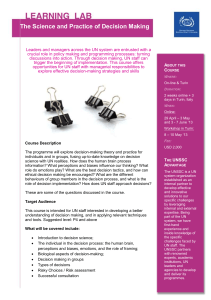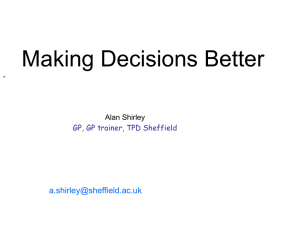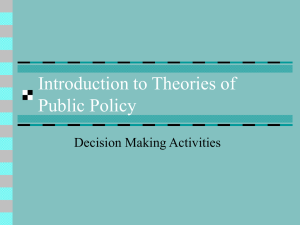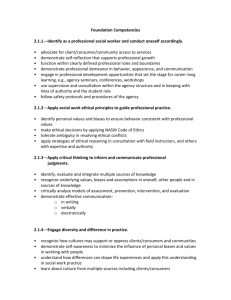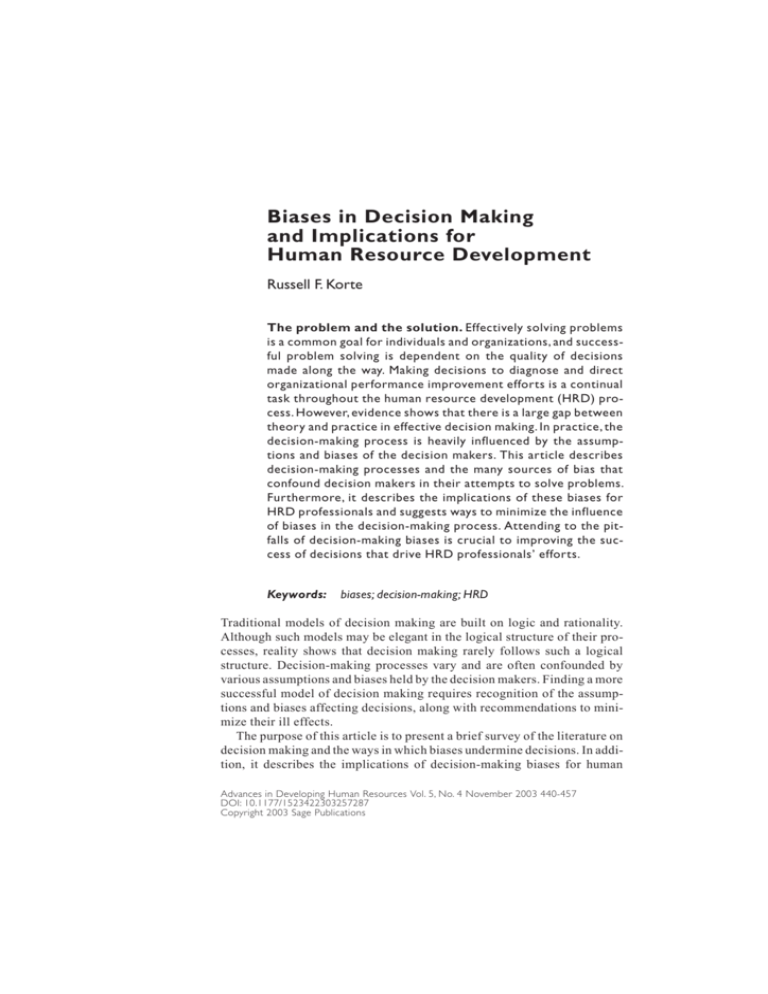
10.1177/1523422303257287
Advances
Korte
/ DECISION
in Developing
BIASES
Human
IN HRD
Resources
ARTICLE
November 2003
Biases in Decision Making
and Implications for
Human Resource Development
Russell F. Korte
The problem and the solution. Effectively solving problems
is a common goal for individuals and organizations, and successful problem solving is dependent on the quality of decisions
made along the way. Making decisions to diagnose and direct
organizational performance improvement efforts is a continual
task throughout the human resource development (HRD) process. However, evidence shows that there is a large gap between
theory and practice in effective decision making. In practice, the
decision-making process is heavily influenced by the assumptions and biases of the decision makers. This article describes
decision-making processes and the many sources of bias that
confound decision makers in their attempts to solve problems.
Furthermore, it describes the implications of these biases for
HRD professionals and suggests ways to minimize the influence
of biases in the decision-making process. Attending to the pitfalls of decision-making biases is crucial to improving the success of decisions that drive HRD professionals’ efforts.
Keywords:
biases; decision-making; HRD
Traditional models of decision making are built on logic and rationality.
Although such models may be elegant in the logical structure of their processes, reality shows that decision making rarely follows such a logical
structure. Decision-making processes vary and are often confounded by
various assumptions and biases held by the decision makers. Finding a more
successful model of decision making requires recognition of the assumptions and biases affecting decisions, along with recommendations to minimize their ill effects.
The purpose of this article is to present a brief survey of the literature on
decision making and the ways in which biases undermine decisions. In addition, it describes the implications of decision-making biases for human
Advances in Developing Human Resources Vol. 5, No. 4 November 2003 440-457
DOI: 10.1177/1523422303257287
Copyright 2003 Sage Publications
Kor te / DECISION BIASES IN HRD
resource development (HRD) professionals and suggests ways to minimize
the hazards of biased decision making in HRD.
Decision-Making Processes
Decision-making models have traditionally identified a series of steps that
help the decision maker arrive at the best solution out of a field of alternative
solutions. Such a rational model is based on a linear decision-making process
that includes the steps summarized by Bazerman (1994), as follows:
1.
2.
3.
4.
5.
6.
Define the problem.
Identify the criteria or objectives of the decision.
Weight or prioritize the criteria or objectives of the decision.
Generate alternative courses of action to solve the problem.
Evaluate the alternatives against each criterion or objective.
Compute the optimal decision.
Although the rational model is explicit, general, and based on scientific reasoning and the principles of logic, it contains three serious weaknesses. First, it
does not represent reality. Second, there is growing skepticism of the validity of
using general principles in the absence of specific content knowledge. Finally,
there is an increasing awareness of the biases and other limitations that characterize the thinking of individuals (Wagner, 1991).
The impracticality of the rational model of decision making stems from
core assumptions seldom realized in practice. It assumes the decision maker
(a) has complete knowledge of the situation; (b) knows all the alternative
solutions, along with their consequences and probabilities; (c) objectively
follows the process; and (d) has the goal of maximizing economic gain or
utility. Empirical evidence gathered from decision-making behavior in reallife situations uncovered major flaws with these assumptions (Beach, 1990;
March, 1999).
Decision makers, in real life, seldom balance costs with benefits or strive
to maximize profit. They seldom consider multiple options—usually considering only one option against the status quo—and they seldom make
decisions in isolation—usually decisions are made to incrementally reach
toward a larger goal and offer protection against failure (Beach, 1990). In
organizations, managers have been found to make decisions opportunistically, to “satisfice,” and to jump into action at the first sign of a plausible
idea (Isenberg, 1986).
Decision making is not completely rational. Several studies of managers in
action found little adherence to the rational, linear model of decision making
(Wagner, 1991). These studies describe the tendency of managers to
1. act before all the information was gathered;
2. be preoccupied with one or two concerns that governed their decisions;
441
442
Advances in Developing Human Resources
November 2003
3. have a high tolerance for ambiguity, misinformation, and a lack of
information;
4. use either complex, iterative decision processes or quick, autocratic processes; and
5. rely heavily on intuition.
Studies over the past few decades describe processes of decision making
based more on the limitations of human information processing, the ambiguity
and subjectivity of individual preferences, the inherent conflicts among decision makers, the unpredictability of future preferences, and the extreme complexity of systemic interrelationships (March, 1999). Complex decisions are
more often at the mercy of the confluence of situational, preferential, and political factors than a rational process of diagnosis, evaluation, and selection of the
best solution (Mintzberg, Raisinghani, & Theoret, 1976). From these empirical
studies of decision making, researchers are developing a greater appreciation for
the complexity of problem situations and the irrationalities of decision-making
processes.
Lyles and Thomas (1988) categorized strategic decision-making processes into five approaches that range from systematic, sequential processes to random processes. Each of these approaches differs in its overriding conceptual framework, the assumptions and biases that predominate,
and how the problem is formulated. Generally, the more certainty and structure in a problem situation, the more the decision-making process is systematic and sequential (rational), and the more uncertain and ill-structured the
problem, the more random the decision-making process.
Different decision-making approaches are appropriate for different situations depending on the nature of the problem and the importance of the outcome. Choosing the best decision-making approach requires knowing the
strengths and weaknesses of each approach and matching the approach to
the situation. Critical weaknesses to be understood are the biases inherent in
each approach (Das & Teng, 1999).
Biases in Decision-Making Processes
Das and Teng (1999) categorized general biases inherent within various
decision-making approaches. First, they reviewed the literature on cognitive
biases related to decision making and synthesized the multitude of bias constructs into four broad categories. These are, as follows:
1. Prior hypotheses and focusing on limited targets: Decision makers bring
prior beliefs, or orientations, to the analysis process and focus on
selected interests and outcomes—often ignoring conflicting information.
2. Exposure to limited alternatives: Decision makers reduce problems to
simpler constructs, seek fewer alternatives, and rely on intuition over
rational analysis.
Kor te / DECISION BIASES IN HRD
443
3. Insensitivity to outcome probabilities: Decision makers rely on subjective judgments rather than rational probabilities of outcomes and tend to
see problems as unique—thereby not relevant to the outcomes of past
experiences.
4. Illusion of manageability: Decision makers tend to be overly optimistic—overestimating their level of control—believing they can manage
and correct the consequences of their decisions along the way.
These biases are more or less prominent depending on the decision-making
approach used by the decision maker. The first two biases, prior hypotheses and
focusing on limited targets and exposure to limited alternatives, are mainly
driven by the philosophical orientation of the decision maker. The latter two,
insensitivity to outcome probabilities and illusion of manageability, describe
general information-processing biases.
Many of the current behavioral models of decision making follow a
descriptive approach, concentrating on the information-processing activities of decision makers. Research in this area has shown that decision makers tend to (a) reduce problems into simple constructs and (b) use information selectively based on their beliefs (assumptions and mental models) and
preferences (biases). Decision makers often create analyses and solutions
that reflect their experiences and beliefs and interpret their experience in
ways that support and preserve their beliefs (March, 1999; March & Simon,
1993).
Reducing Problems Into Simple Constructs
Bereiter and Scardamalia (1993) have studied the phenomenon of expertise as it relates to problem solving and decision making. To them, it is a
continuing process whereby the individual acquires ever more depth of
experience and knowledge about a particular domain. This depth helps the
individual solve problems more successfully, but it is not the depth of experience and knowledge alone that makes an expert. It is the skill to efficiently
and effectively solve problems that differentiates the expert from the knowledgeable and experienced nonexpert (Swanson & Holton, 2001, p. 238).
Experts and nonexperts can be differentiated by their methods of problem solving. Problem reduction and progressive problem solving are two
different methods for solving complex, real-world problems. Problem reduction reduces a problem into simpler definitions that can be resolved more
easily and is characteristic of nonexpert problem solving. Although breaking problems down into simpler constructs aids in the resolution of these
simplified problems, it also may lead the decision maker further away from
the true nature of the problem. The more a problem is reduced or simplified,
the less it represents the true problem—especially if the problem is complex. The assumption that reducing a problem into more manageable (simpler) subgoals allows the organization to eventually achieve the overall goal
444
Advances in Developing Human Resources
November 2003
is often problematic. It causes decision makers within the organization to
ignore factors not perceived to be directly related to the problem (Sterman,
2000).
Progressive problem solving is more successful for problems that are
complex and ill-structured and therefore not well-served by reduction into
simpler definitions (Bereiter & Scardamalia, 1993). Newell and Simon (1972)
described ill-structured problems as having goals that are not well-defined
up front. These problems may generate large sets of possible solutions, lead
to solutions not feasible within normal activity, and require costly testing to
verify. Under these conditions, the goal may only take shape as a solution is
implemented. Progressive problem solving is an iterative strategy that often
implements successive or partial solutions to better define a problem at
higher levels of complexity (Bereiter & Scardamalia, 1993).
Restructuring a problem can enlarge the scope of a problem as well as
reduce the scope. Reducing the scope or simplifying the definition does not
effectively resolve complex problems—particularly those of a strategic
nature. Brightman (1980) recommended the ongoing use of multiple definitions of a problem from multiple viewpoints and resisting the desire to craft
a singular, simple definition. Retaining multiple definitions of a problem
requires a higher level of thinking about a problem.
Higher level thinking, as described in cognitive development models, is
dialectic and characterized by an understanding that knowledge is contextual and complex. At lower levels of thinking, thinkers seek the clarity of
right and wrong answers (Merriam & Caffarella, 1999). Higher levels of
thinking are required of decision makers in order to assess the facts and perceptions surrounding complex, systemic problems. Progressive problemsolving strategies strive to forestall the tendency by decision makers to
focus too narrowly on a problem and jump to conclusions.
Selective Use of Information
Decision-making strategies employed by individuals usually are based
on loosely defined rules (heuristics). Although these “rules of thumb” often
allow individuals to reach satisfactory and successful outcomes, they also
inject systematic biases into decision-making processes and increase the risk
of failure as problems become more complex and ill-structured (Bazerman,
1994). These biases stem from individual orientations and the methods of
information processing employed by individuals.
Researchers studying decision making are increasingly aware of the
biases and other cognitive limitations that characterize the use of information by individuals as they solve problems. Hogarth (1987) has identified 14
common biases in the information-gathering, information-processing, and
information-response phases of decision making.
Kor te / DECISION BIASES IN HRD
During the information-gathering phase, individuals tend to overestimate the importance of information that is highly visible and acquired early
in the process. Also, individuals will have greater difficulty understanding
problems outside of their direct experience. This tends to lead people to discover what they expect to discover. In the information-processing phase,
individuals tend to evaluate information inconsistently and to retain preconceived opinions and solutions. In the information-response phase, individuals are prone to wishful thinking, including the tendency to overestimate
their control over outcomes (Hogarth, 1987). These biases influence the
consequences of decisions and increase the risks as problems become more
complex and ill-structured.
At a strategic level, problems are often complex and ill-structured, and
decision makers tend to rely more on intuition, heuristics, and uninformed
judgment. In these situations, decision makers are bounded by the constraints of their memory, preferences (biases), and the environment. Therefore, it is wise to continuously challenge decisions and the assumptions on
which they are based.
The prevalence of biases in the decision-making process is a major
source of concern for effective problem solving. In practice, little attention
is given to the quality of the information-gathering, information-processing,
and information-response phases that frame the initial direction for problem
resolution. This leaves decision makers at the mercy of confounded processes in their efforts to define problems and construct solutions.
Individuals must continuously challenge the assumptions and orientations that bound their decision-making processes. Assumptions range from
strongly held philosophical beliefs to more simple beliefs of cause and
effect. Paradigmatic assumptions are those that are believed to be the objective facts or truths about reality (i.e., philosophical orientations). They are
the hardest to uncover, and challenging them is usually met with great resistance. Prescriptive assumptions involve what people think should be happening. For example, many believe that training is the primary method to
improve performance. This particular prescription is based on an assumption that deficient individual knowledge and skills are the major cause of
poor performance. Causal assumptions are the predictors used to develop
recommendations and solutions. These are the easiest to identify and
challenge (Brookfield, 1995). Throughout the decision-making process,
decision makers must rigorously challenge their thinking to uncover the
assumptions and biases that control the decision-making process.
Biases and assumptions influence problem-solving activities and decisions in a variety of ways, leading to the high probability that different problem solvers will reach different conclusions about a problem. If one considers that problem-solving processes are built on a series of decisions made by
the decision makers in an organization, then one has to take into account the
445
446
Advances in Developing Human Resources
November 2003
multitude of biases and misjudgments as well as the insights and intelligence that lead to the outcomes of problem solving (see Table 1).
Successful Decision-Making Strategies
for Coping With Biases
An extensive study of management decision-making processes identified methods that were prone to success or failure. Over a 20-year period,
Nutt (2002) studied more than 400 management decisions and identified
common characteristics that improved the success of decisions or led to
suboptimal or failed decisions.
Nutt (2002) found two types of decision-making processes—one that increases
the chances of success and one that increases the chances of failure. The discovery process is the more successful of the two. Key components of this process
are, as follows:
1. a deliberate and thorough study of the claims made by a variety of
stakeholders,
2. early attention to social and political interests, and
3. setting a direction based on a cross-section of informed opinion (Nutt,
2002, pp. 46-49).
The second process is prone to suboptimization or failure. He calls this the
idea-imposition process, whereby pragmatism and the urgency to act push decision makers to settle on an idea too early. A key flaw of this approach becomes
evident when evaluating alternative solutions, whereby most of the effort is
spent defending the chosen idea rather than evaluating a range of possible ideas
(Nutt, 2002).
In contrast, a systems view of the organization sees it as a complex of various inputs, processes, and outputs interacting at multiple levels. This view
correlates to the success-prone discovery process of decision making. Nutt
(2002) advocated the assessment of input from multiple stakeholders representing various positions inside and outside the organization: He described
this as the “arena of action” (p. 50), and it is effective when broad-based and
collaborative.
Two of the chief benefits of the discovery process are (a) the collection,
analysis, and understanding of a large amount of information related to the
decision and (b) the broader network of informed people who understand
what the decision is about and why it is wise to act. Rigorous attention to the
breadth of information and the sociopolitical influences of decisions leads
to better results.
Nutt (2002) also identified the pervasive tendency to abort the discovery
process at any time and switch to the idea-imposition process as a result of
increasing impatience from stakeholders. Besides the pressure to find a
TABLE 1:
Biases in Decision Making
Bias
Sources of Bias
Consequence of Bias
Prior hypothesis and focus
on limited targets
Philosophical orientation, memory, assumptions, Framing the problem or situation narrowly, failing
experience, mental models
to recognize multiple causes and complex
interrelationships
Exposure to limited
alternatives
Narrowly framed problem or situation,
incomplete information, reliance on intuition
Insensitivity to outcome
probabilities
Influenced by the value of an outcome rather
Subjective selection of alternative solutions, little
than the probability, considering each problem
attention to related experience or prior outcomes
as unique
Illusion of manageability
Overly optimistic estimates of success, overly
optimistic assessments of control over
outcomes
Alternatives selected subjectively based on unrealistic
estimates of success, risk unduly minimized, undue
belief in the ability to control the problem
Information gathering
Memory, recall, expectations, influence of
framing
Selective attention or disregard to information
Information processing
Inconsistent judgment, heuristics, anchoring,
environmental influences
Information is subjectively analyzed and assessed
Information response
Wishful thinking, illusion of control,
Unrealistic expectations of success, subjective
misperceptions of success or failure, hindsight
construction of responses
Source: Based on Das and Teng (1999) and Hogarth (1987).
Missing important causes of the problem,
overlooking important alternatives for resolution
447
448
Advances in Developing Human Resources
November 2003
solution quickly (efficiently), powerful stakeholders may themselves identify the problem, define it, and dictate a solution. They then impose their
view on the process and push to “get on with it.” Consequently, the decision
maker may be pressured to impose the favored solution on the other stakeholders by resorting to persuasion and authority. The benefits of generating
multiple ideas and building support among stakeholders are then lost.
The evidence shows the idea-imposition process to be less successful
than the discovery process. Evidence also shows that there is a large gap
between theory and practice in decision making. The cause of this gap is a
combination of the complexity of problems and the limitations of decision
makers to effectively analyze a problem and avoid the influences of biases in
the process (Brightman, 1980). Awareness of these limitations is the first
step to guarding against their influence. Knowledge and understanding of
the types of biases inherent in the decision-making process, along with
action to reduce their effects, will inevitably lead to better decisions.
Decision-Making Biases in HRD
Theoretical concepts regarding organizational performance garner widespread support among HRD professionals. However, in practice, differing
philosophical orientations, preferences, and assumptions create different
outcomes when these theories are applied.
One of the commonly agreed-on concepts in HRD is the need to systematically analyze a situation before a solution is designed, developed, and
implemented (Sleezer, 1992). Although decision-making activity is inherent throughout the HRD process, the analysis phase of this process is often
cited in the literature as the most critical for achieving successful outcomes
(Gilley, 2001). This article continues the discussion of decision-making
biases by focusing on the often ill-structured and complex conditions found
in the analysis phase of HRD. It is perhaps the least structured phase of the
HRD process.
Most process models of HRD start with a systematic analysis of the situation, followed by the design, development, implementation, and evaluation
of a solution. Analysis is the foundation that drives the HRD process
(Rossett, 1992). Analysis identifies the problem or opportunity, gathers
data, and recommends a solution (Swanson, 1994). To do this successfully,
the analyst and the organization depend on their skills as decision makers
and problem solvers.
In the analysis phase, decisions are made regarding how to represent the
problem, where to collect data, what data to collect, how to analyze the data,
what conclusions to draw, and what recommendations to make for resolving
the problem. All these decisions reflect the assumptions (beliefs) and preferences (biases) of the decision makers and are extraordinarily arbitrary and
Kor te / DECISION BIASES IN HRD
random (March & Simon, 1993). Whether the problem requires improving
organizational performance, implementing organizational change, or fostering individual learning—the assumptions and biases of the analyst, decision makers, and stakeholders will inevitably direct the definition of the
problem and the proposed solution (Sleezer, 1993).
Most analysis methods start with a prescription for defining the problem,
but few explicitly recognize the level of difficulty, or near impossibility, of
this crucial task. Although some of the up-front analysis processes used in
HRD acknowledge the effect of the preferences held by the organization,
decision maker, and analyst (Sleezer, 1991), little guidance is subsequently
offered for conducting successful decision making within these constraints.
The purpose of the next section is to identify some of the sources of the
biases that affect decision making in the analysis phase of HRD and to
describe the expertise required to improve decision making within this critical phase.
Decision Making in the Analysis Phase of HRD
HRD professionals disagree about exactly what the analysis phase
involves (Sleezer, 1992). Even reaching agreement on the terminology and
clarifying expectations is troublesome in a group with different philosophical orientations and expectations about the HRD process.
Sleezer (1992) identified four perspectives associated with the analysis
phase and, in her review of the literature, found various definitions for each.
Needs assessment, needs analysis, front-end analysis, and performance
analysis each have different meanings to different people in the field. For
example, the term needs assessment was used by some to label the specific
information-gathering process within the analysis phase. Others used the
same term to describe only one of four information-gathering processes,
and still others used this term to identify the entire analysis phase. A lack of
clarity about the terms describing the analysis process contributes to various
interpretations among members of the analysis team, leading to various
expectations and outcomes from the analysis.
Behind the various interpretations of key terms, there are differing
beliefs about the purpose of HRD. Different philosophical orientations
guide professionals along different paths within the analysis phase. Gilley
(2001) identified three philosophical orientations within HRD and described
the purposes and preferences that drive each of these. Professionals oriented
toward learning and development prefer learning solutions, those oriented
toward performance improvement prefer management action, and those oriented toward organizational change prefer change management solutions.
Underlying one’s philosophical orientation is a set of biases and assumptions that govern decision-making strategies. The preferred solutions men-
449
450
Advances in Developing Human Resources
November 2003
tioned above do not identify objective facts about these orientations—they
identify the assumptions and biases that drive the different orientations.
These assumptions and biases may be attributed to the organization as easily
as they are attributed to the individual.
Explicit biases toward a predetermined outcome are more easily challenged than the implicit biases and assumptions that drive one’s cognitive
approach to decision making. As Sleezer (1993) pointed out, the experiences, biases, and assumptions of the organization and the analyst are one of
the critical determinants of the analysis outcome (e.g., the problem statement). Although an outcome is more explicit, the identification of the cause
is generally more implicit. Identifying a problem to be solved often entails
the assumption of a pre-determined cause, and the analysis of the problem
may follow the assumption in supporting the cause. Brinkerhoff (1998)
challenged decision makers to remain nonjudgmental in seeking causal evidence for a problem and to avoid the temptation to selectively interpret data
supporting predetermined outcomes.
The danger of a restricted philosophical orientation is the tendency to narrowly define a problem. Swanson (1994) called this a single-dimension view of
organizations. He described four single-dimension views (orientations) that are
prevalent among performance improvement professionals:
1. The power view is focused on the politics of the organization and is usually behind the delivery of solutions to meet with the approval of upper
management.
2. The economic view concentrates on financial transactions, looking for
the best return on investment.
3. The mechanistic view sees the organization narrowly as a machine that
needs to be fixed or maintained.
4. The humanistic view puts the importance of the individual above all
other priorities.
According to Nutt (2002), adherence to any of these singular views risks
making decisions under the failure-prone idea-imposition process. This process
latches onto an idea early and dismisses the viewpoints of stakeholders outside
the decision maker’s orientation. In addition, a decision maker with this restricted
view often uses information selectively to support the predetermined idea rather
than using broad-based information to fully understand the situation.
Defining problems is an important component of the analysis process.
Inevitably, the analysis process leads to differing formulations of a problem
based on the various orientations and biases of stakeholders, organizational
cultures, and the decision-making team (Sleezer, 1991). Even expert analysis is not an exact science leading to the one best solution as prescribed in the
rational model of decision making.
For HRD professionals to contribute to the improvement of the organization, the quality of their problem-solving and decision-making skills must
Kor te / DECISION BIASES IN HRD
be at a consistently high level. Current HRD competency models require
problem-solving and decision-making skills but do not offer guidance for
the practitioner, nor do they describe the expertise required. Without this
expertise, the analyst is at the mercy of hidden biases and failure-prone processes. With this expertise, the analyst can minimize the effects of biases
and better optimize the analysis phase. Rothwell (1996) described this
expertise for HRD professionals as requiring a high level of analytical and
observational skills, problem-solving skills, communication skills, and
business acumen. Add to that a high level of decision-making skills.
HRD professionals focused on improving the performance of the organization must push themselves to tackle complex problems that spread beyond
the realm of their professional orientations. To do this successfully requires
the skills to efficiently and effectively manage the complex interrelationships among organizational stakeholders, politics, competing philosophies,
and individual perceptions and assumptions. It also requires the use of rigorous problem-solving and decision-making processes.
Problem Solving and Decision Making
in Practice: A Case Study Example
The value of expert problem solving and successful decision-making strategies comes from their practicality in practice. A case study by MacDuffie (1997)
provides a good example of the influence of context and orientation on analysis
outcomes. He analyzed the problem-solving and decision-making processes
involving identical types of quality improvement problems in three different
automobile manufacturing plants. The problems were chosen for their complexity and were characterized as
1. not easily traced to one source,
2. involving the interaction of multiple departments with human and technological factors, and
3. not resolvable through standard procedures or methods.
Comparing the differences in problem-solving strategies among the three
plants identified the influence of differences in the structure and culture of the
organizations as well as their quality systems. The differences in structure and
culture ranged from an organization with a traditional, authoritarian hierarchy to
a more collaborative, less hierarchical organization.
Differences in these environments produced differences in the definitions, analyses, and solutions to a similar problem in each case. For example, a culture based on rigid departmental structures inherently defined
problems to avoid crossing departmental boundaries, whereas the culture
that encouraged flexibility and interdepartmental collaboration concentrated on finding the cause of the problem wherever it led. Another key dif-
451
452
Advances in Developing Human Resources
November 2003
ference was whether the analysis of the problem was for accountability
(blame) or diagnostic (cause) purposes. This study highlighted the diverse
outcomes possible from the analysis of identical problems due to the various
influences of cultural biases.
MacDuffie (1997) concluded from his study that problem solving and decision making are improved by the following:
1.
2.
3.
4.
5.
a rich set of data capturing multiple perspectives;
information about the context of the problem;
using “fuzzy” categories instead of forcing problems into rigid categories;
framing problems as opportunities, not liabilities;
an organizational culture that facilitates communication across boundaries and develops a common language regarding a problem; and
6. an organization that evaluates problems and solutions first in terms of
quality, then cost.
This case study supports the characteristics of successful problem-solving
and decision-making processes described by Nutt (2002), Hogarth (1987), and
Berieter and Scardamalia (1993). It also places these processes within the context of organizational cultures, systems, and the decision-making assumptions
and biases that influence the outcomes of analyses.
Implications for Research and Practice
Faced with the ambiguous and dynamic nature of problem solving, it is
critical to minimize the detrimental effects of subjectiveness and bias when
identifying and defining performance problems. Decision makers must
solicit and examine diverse viewpoints, and consider a broad range of
alternative solutions. According to the research on decision making, both of
these actions increase the chances of finding successful solutions (Nutt, 2002).
The decisions made in the HRD process must be rigorously analyzed.
Evaluating decisions is a form of quality control often overlooked in HRD
methods. Rothwell and Kazanas (1992) recommended that decision makers
thoughtfully describe how decisions will be made from the data, keep track
of the reasons for the decisions that are made, and justify them to others
based on the data collected and the methods of analyzing the data. This type
of reflection and evaluation of the decision process is not explicit in many
HRD models or methods. Furthermore, a formal analysis and evaluation of
potential assumptions and biases affecting the decision process is not built
into most methodologies. Although detailed methods are prescribed for
analyzing behaviors, tasks, and performance gaps, little attention is paid to
the important process of making the decisions that drive these methods. The
lack of attention toward the decision-making process by decision makers
risks the continued reinforcement of existing assumptions and biases within
decision makers and organizations.
Kor te / DECISION BIASES IN HRD
Further research is needed to increase understanding of the relationships
between cognitive biases, problem solving, decision making, and the outcomes of HRD efforts. Expert problem solving requires high-level analytical and decision-making skills, along with an appreciation for the complex,
systemic nature of problems. More research is also needed to close the gap
between decision-making theory and practice. There is a need to better
understand the complex reality of problem solving and decision making to
design better models and tools for HRD professionals.
The following principles provide guidance that can be used by decision
makers (see Table 2). The purpose of these principles is to make explicit the
need for evaluating and rationalizing the decision process and the subsequent decisions that drive the identification and definition of problems and
the selection of solutions. As stated earlier, the identification and definition
of a problem direct the design, implementation, and evaluation of HRD
efforts, all of which are highly influenced by the preferences and biases of
the organization and decision makers (Sleezer, 1993).
Conclusion
Complex problems consume a large portion of an organization’s resources.
These problems are not easily solved through simple procedures, methods,
or intuition. Rigorous analysis and expert problem-solving skills are required.
To be effective, decision making must account for the characteristics of
the stakeholders, decision makers, and the analyst as they interact to define a
problem and generate a solution. If undertaken from a broader, performanceimprovement viewpoint, problem solving is a complex process rife with
social and political agendas, individual biases, and rapidly changing relationships. Yet, no matter how rigorous the process, the definition of a problem is only a representation of the true nature of the problem. This may lead
to the conundrum that many complex, real-world problems are incapable of
being defined completely or accurately (Gause & Weinberg, 1990).
It is a formidable challenge to make the right decisions—especially when
there is little agreement, support, or evidence that a decision is right. However, there is evidence that the success of decisions is improved by attending
to the principles described above and working to minimize the biases that
undermine decision-making processes.
A rigorous decision-making process must include an explicit examination and challenge of the assumptions and biases underpinning the process
and a prescription to mitigate the stifling effects of these orientations. Based
on the research into problem-solving and decision-making processes, the
principles offered in Table 2 provide guidance for making better decisions
throughout the HRD process.
453
454
TABLE 2:
Optimizing and Suboptimizing Practices for Decision Making in HRD
Optimizing Practices for Decision Making
Suboptimizing Practices for Decision Making
Bias analysis
Identify, assess, and challenge the orientations and
underlying assumptions of the analysis and
decision-making team.
Ignore or gloss over the orientations and
assumptions of the team.
Informationgathering phase
Choose sources of information based on
Challenge the information-gathering process to identify
(a) experience, (b) visible sources, (c) preferred
potential biases from (a) visibility, (b) timing, (c) limits
sources. Consider a limited variety of
of understanding, (d) expectations, (e) comparisons,
perceptions and claims about the situation, focus
(f) experience. Search out and consider a wide variety
on select sources.
of perceptions and claims about the situation, include
perceptions from outside the analysis team and the
organization (triangulation). Generate multiple definitions
and solutions of the problem and do not settle on a
definition of the problem or solution until late in the
process, if at all.
Informationprocessing phase
Challenge the information-analysis process to identify
Analyze data (a) with inconsistent use of criteria,
potential biases from (a) inconsistency, (b) conservatism, (b) to support preferences, (c) with overconfi(c) miscalculation, (d) inertia, (e) overconfidence, (f)
dence on biased data. Unilaterally analyze the
anchoring. Collaboratively analyze the claims and data
claims and data related to the problem. Offer
related to the problem. Explain reasons for processing
analysis of information without
information and justify the reasons based on the data.
rigorous justification of methods. Use predeterUse “fuzzy” categories to classify problems.
mined, rigid categories to classify problems.
Informationresponse phase
Enlist several nonaligned sources for reality checks of
analysis, definitions, and solutions. Attend to the
perceptions, expectations, and impulses of the
stakeholders throughout the process.
Unduly hope for the best and overestimate the
degree of control or the ability to fix things later.
Stick to the objective facts and downplay the
subjective characteristics of stakeholders.
General problemsolving and
decision-making
practices
Consider that the problem can never be completely
Focus on a single definition of the problem and
defined or completely resolved. Follow the natural,
solution. Follow a linear, mechanistic problemconvoluted flow of problem-solving processes. Avoid
solving process. Take action early in the process.
the impulse to act early in the process (undertake early
action only to test possible ideas and solutions).
455
456
Advances in Developing Human Resources
November 2003
References
Bazerman, M. H. (1994). Judgment in managerial decision-making (3rd ed.). New York:
John Wiley.
Beach, L. R. (1990). Image theory: Decision-making in personal and organizational
contexts. Chichester, UK: Wiley.
Bereiter, C., & Scardamalia, M. (1993). Surpassing ourselves: An inquiry into the nature
and implications of expertise. Chicago: Open Court.
Brightman, H. J. (1980). Problem solving: A logical and creative approach. Atlanta:
Georgia State University, Business Publishing Division.
Brinkerhoff, R. O. (1998). Measurement phase: Evaluating effectiveness of performance
improvement projects. In D. G. Robinson & J. C. Robinson (Eds.), Moving from training to performance: A practical guide (pp. 147-174). San Francisco: Berrett-Koehler.
Brookfield, S. D. (1995). Becoming a critically reflective teacher. San Francisco: JosseyBass.
Das, T. K., & Teng, B. S. (1999). Cognitive biases and strategic decision processes: An
integrative perspective. Journal of Management Studies, 36, 757-778.
Gause, D. C., & Weinberg, G. M. (1990). Are your lights on? How to figure out what the
problem really is. New York: Dorset House.
Gilley, J. W. (2001). An overview of the professional practice domains of HRD: Organizational learning, performance, and change. In J. W. Gilley, P. J. Dean, & L. L.
Bierema (Eds.), Philosophy and practice of organizational learning, performance,
and change. New perspectives in organizational learning, performance, and change
(pp. 1-11). Cambridge, MA: Perseus.
Hogarth, R. M. (1987). Judgment and choice: The psychology of decision (2nd ed.).
Chichester, UK: Wiley.
Isenberg, D. J. (1986). Thinking and managing: A verbal protocol analysis of managerial
problem solving. Academy of Management Journal, 29(4), 775-788.
Lyles, M. A., & Thomas, H. (1988). Strategic problem formulation: Biases and assumptions embedded in alternative decision-making models. Journal of Management
Studies, 25, 131-145.
MacDuffie, J. P. (1997). The road to “root cause”: Shop floor problem-solving at three
auto assembly plants. Management Science, 43, 479-502.
March, J. G. (1999). The pursuit of organizational intelligence. Malden, MA: Blackwell.
March, J. G., & Simon, H. A. (1993). Organizations (2nd ed.). Cambridge, MA:
Blackwell.
Merriam, S. B., & Caffarella, R. S. (1999). Learning in adulthood: A comprehensive
guide (2nd ed.). San Francisco: Jossey-Bass.
Mintzberg, H., Raisinghani, D., & Theoret, A. (1976). The structure of “unstructured”
decision processes. Administrative Science Quarterly, 21, 246-275.
Newell, A., & Simon, H. A. (1972). Human problem solving. Englewood Cliffs, NJ:
Prentice Hall.
Nutt, P. C. (2002). Why decisions fail: Avoiding the blunders and traps that lead to debacles. San Francisco: Berrett-Koehler.
Kor te / DECISION BIASES IN HRD
Rossett, A. (1992). Analysis of human performance problems. In H. D. Stolovitch & E. J.
Keeps (Eds.), Handbook of human performance technology: A comprehensive guide
for analyzing and solving performance problems in organizations (pp. 97-113). San
Francisco: Jossey-Bass.
Rothwell, W. J. (1996). Beyond training and development: State-of-the-art strategies for
enhancing human performance. New York: American Management Association.
Rothwell, W. J., & Kazanas, H. C. (1992). Mastering the instructional design process: A
systematic approach. San Francisco: Jossey-Bass.
Sleezer, C. M. (1991). Developing and validating the performance analysis for training
model. Human Resource Development Quarterly, 2(4), 355-372.
Sleezer, C. M. (1992). Needs assessment: Perspectives from the literature. Performance
Improvement Quarterly, 5(2), 34-46.
Sleezer, C. M. (1993). Training needs assessment at work: A dynamic process. Human
Resource Development Quarterly, 4(3), 247-263.
Sterman, J. D. (2000). Business dynamics: Systems thinking and modeling for a complex
world. Boston: Irwin McGraw-Hill.
Swanson, R. A. (1994). Analysis for improving performance: Tools for diagnosing organizations and documenting workplace expertise. San Francisco: Berrett-Koehler.
Swanson, R. A., & Holton, E. F., III. (2001). Foundations of human resource development. San Francisco: Berrett-Koehler.
Wagner, R. K. (1991). Managerial problem solving. In R. J. Sternberg & P. A. Frensch
(Eds.), Complex problem solving: Principals and mechanisms (pp. 159-183). Hillsdale,
NJ: Lawrence Erlbaum.
Russell F. Korte is a graduate student in human resource development and adult
education at the University of Minnesota. His experience includes research and
practice in marketing, education, training, and performance improvement.
Korte, R. F. (2003). Biases in decision making and implications for human resource
development. Advances in Developing Human Resources, 5(4), 440-457.
457
Request Permission or Order Reprints Instantly
Interested in copying, sharing, or the repurposing of this article? U.S. copyright law, in
most cases, directs you to first get permission from the article’s rightsholder before using
their content.
To lawfully obtain permission to reuse, or to order reprints of this article quickly and
efficiently, click on the “Request Permission/ Order Reprints” link below and follow the
instructions. For information on Fair Use limitations of U.S. copyright law, please visit
Stamford University Libraries, or for guidelines on Fair Use in the Classroom, please
refer to The Association of American Publishers’ (AAP).
All information and materials related to SAGE Publications are protected by the
copyright laws of the United States and other countries. SAGE Publications and the
SAGE logo are registered trademarks of SAGE Publications. Copyright © 2003, Sage
Publications, all rights reserved. Mention of other publishers, titles or services may be
registered trademarks of their respective companies. Please refer to our user help pages
for more details: http://www.sagepub.com/cc/faq/SageFAQ.htm
Request Permissions / Order Reprints

